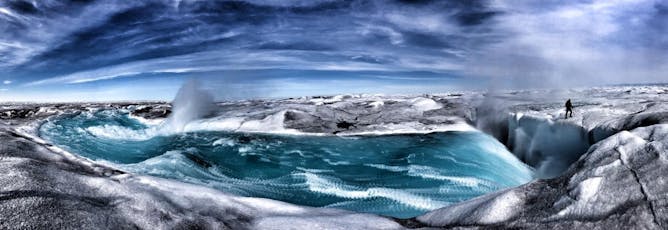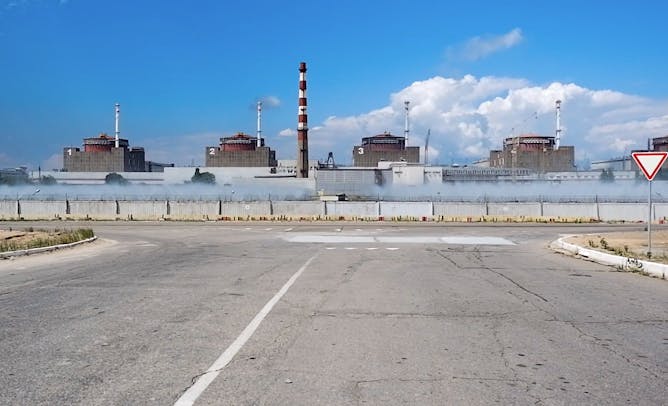|
One of the most vexing medical mysteries to come from the pandemic is long COVID-19. Immunologist Matthew Woodruff has been investigating the links between the body’s immune response and severe COVID-19 since the early days of the pandemic and writes about his latest research, published in the journal Nature today. The study shows that “rogue antibodies” that attack people’s own tissues are present in people with long COVID-19, an important finding that can lead to better treatments.
Another study that got widespread attention this week came from glaciologist Alun Hubbard, who has spent decades conducting research on Greenland’s ice sheet. In an evocative story with photos taken by Hubbard, he writes about the dramatic changes he’s seen and what they mean for the world – notably, at least 10 inches of global sea level rise. “The current generation of coupled climate and ice sheet models used to forecast future sea level rise fail to capture the emerging processes that we see amplifying Greenland’s ice loss,” he writes.
News this morning that inspectors from the United Nations’ nuclear watchdog agency have arrived in Ukraine to monitor the Zaporizhzhia Nuclear Power Plant provides some level of assurance. But with the plant in a war zone, the situation remains worrying. Nuclear safety expert Najmedin Meshkati from the University of Southern California explains the most important risks to operation of the plant and calls for “active, pragmatic engineering and nuclear diplomacy.”
Also in this week’s science news:
If there’s a subject you’d like our team of science editors to investigate, please reply to this email.
|

Approximately 30% of people who get COVID-19 develop long-term symptoms, or long COVID-19.
Boy Anupong/Moment via Getty Images
Matthew Woodruff, Emory University
A new study finds that misdirected immune responses can persist for months in those who are suffering from long COVID-19.
|

A turbulent melt-river pours a million tons of water a day into a moulin, where it flows down through the ice to ultimately reach the ocean.
Ted Giffords
Alun Hubbard, University of Tromsø
A field glaciologist explains the changes scientists are now seeing.
|

The Zaporizhzhia nuclear power plant in Ukraine is being operated by Ukrainian technicians while occupied by Russian troops.
Russian Defense Ministry Press Service via AP
Najmedin Meshkati, University of Southern California
Artillery shelling, stressed-out technicians and power supply disruptions increase the chances of catastrophe at the Zaporizhzhia nuclear power plant, Europe’s largest.
|
|
|
-
Omer Gokcumen, University at Buffalo
A vast array of species, including people, use slime for a variety of essential bodily functions. Studying the genetic ancestry of slime surprisingly showcases the role of repetitive DNA in evolution.
-
Jack Burns, University of Colorado Boulder
When the Orion Crew Capsule orbits the Moon there will be no one on board. But the mission will mark a key step in bringing humans back to Earth’s dusty sidekick.
-
Andrew Stokes, Boston University; Dielle Lundberg, Boston University; Elizabeth Wrigley-Field, University of Minnesota; Rafeya Raquib, Boston University
Early on, public health messaging focused on the need for vaccines to combat COVID-19. But far less attention has been given to the role of boosters in preventing deaths and reducing inequities.
-
Agnès Lacreuse, UMass Amherst; Allyson J. Bennett, University of Wisconsin-Madison; Amanda M. Dettmer, Yale University
Nonhuman primates like rhesus monkeys share certain characteristics with people that may make them better study subjects than mice for research on neurodegenerative diseases.
-
Sam Hunter, University of Nebraska Omaha; Gina Scott Ligon, University of Nebraska Omaha
Those who seek to cause harm are as capable of generating creative ideas as anyone else. Two psychologists and counterterrorism scholars suggest how not to overlook a new danger.
-
Yuta Senzai, University of California, San Francisco; Massimo Scanziani, University of California, San Francisco
Why your eyes move during the REM stage of sleep has puzzled scientists for years. Researchers measured mice brains to look for a possible explanation.
|
|